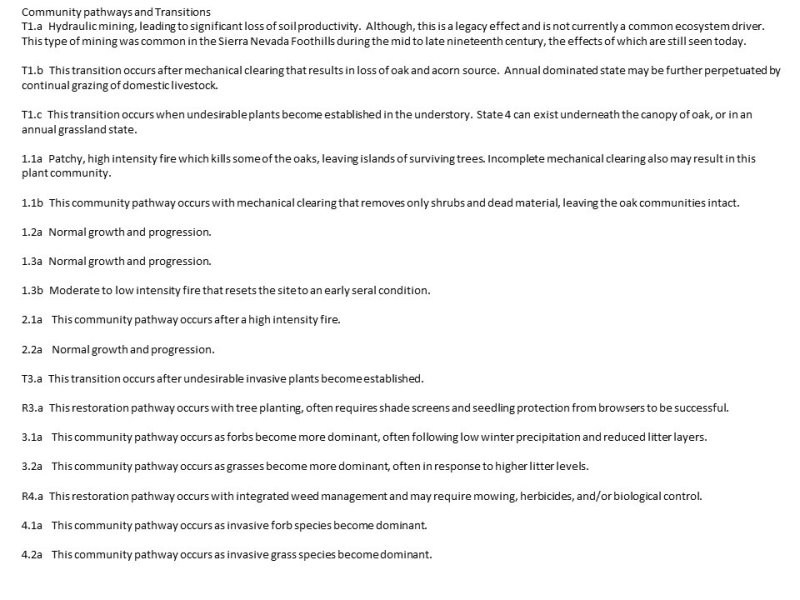

Natural Resources
Conservation Service
Ecological site F018XI206CA
Clayey Thermic Marble Hills
Last updated: 4/24/2024
Accessed: 12/21/2025
General information
Provisional. A provisional ecological site description has undergone quality control and quality assurance review. It contains a working state and transition model and enough information to identify the ecological site.
MLRA notes
Major Land Resource Area (MLRA): 018X–Sierra Nevada Foothills
Major Land Resource Area (MLRA) 18, Sierra Nevada Foothills is located entirely in California and runs north to south adjacent to and down-slope of the west side of the Sierra Nevada Mountains (MLRA 22A). MLRA 18 includes rolling to steep dissected hills and low mountains, with several very steep river valleys. Climate is distinctively Mediterranean (xeric soil moisture regime) with hot, dry summers, and relatively cool, wet winters. Most of the precipitation comes as rain; average annual precipitation ranges from 15 to 55 inches in most of the area (precipitation generally increases with elevation and from south to north). Soil temperature regime is thermic; mean annual air temperature generally ranges between 52 and 64 degrees F. Geology is rather complex in this region; there were several volcanic flow and ashfall events, as well as tectonic uplift, during the past 25 million years that contributed to the current landscape.
LRU notes
This LRU (designated XI) is located on moderate to steep hills in the Sierra Nevada Foothills east of Sacramento, Stockton, and Modesto, CA. Various geologies occur in this region: metavolcanics, granodiorite, slate, marble, argillite, schist and quartzite, as well as ultramafic bands to a limited and localized extent. It includes mesa formations from volcanic flows, where vernal pool habitats occur. Soil temperature regime is thermic and soil moisture regime is xeric. Elevation ranges between 300 and 3400 feet above sea level. Precipitation ranges from 14 to 42 inches annually. Most precipitation falls between the months of November and March in the form of rain. Dominant vegetation includes annual grasslands, blue oak (Quercus douglasii), interior live oak (Quercus wislizeni), chamise (Adenostoma fasciculatum), buckbrush (Ceanothus cuneatus), and foothill pine (Pinus sabiniana).
Classification relationships
CLASSIFICATION RELATIONSHIPS
This site is located within M261F, the Sierra Nevada Foothills Section, (McNab et al., 2007) of the National Hierarchical Framework of Ecological Units (Cleland et al., 1997), M261Fb, the Lower Foothills Metamorphic Belt Subsection.
Level III and Level IV ecoregions systems (Omernik, 1987, and EPA, 2011) are: Level III, Central California Foothills and Coastal Mountains and Level IV, Ecoregion 6b, Northern Sierran Foothills, Ecoregion 6c, Comanche Terraces.
Ecological site concept
This site is found on clayey soils on strongly sloping to moderately steep hills. It occurs on all hill slope positions except for toeslopes in marble-derived parent material. Slopes range from 3 to 30%. Mean annual precipitation typically ranges from 26 to 33 inches.
The overriding factor in this site is the accumulation of clay minerals in both the surface (representative value ~ 26%) and soil subsurface (20 inches; representative value ~ 36%). The presence of 2:1 clay minerals may stunt plant growth, and may overcome the influence of relatively high precipitation in this site. The main soil components associated with this ecological site are Aquariusmine and Beybek components. Aquariusmine soils are deep and occur on backslope positions. They are fine-loamy, mixed, active, thermic Ultic Haploxeralfs. The soil properties of Beybek are more telling of a clayey site. They are classified as clayey-skeletal, mixed, superactive, thermic Leptic Haploxererts.
This vegetation consists of often stunted blue oak (Quercus douglasii) and interior live oak (Quercus wislizeni) and scattered shrubs such as manzanita (Arctostaphylos spp.) and poison oak (Toxicodendron diversilobum). This site also has abundant annual grasses and forbs in the understory.
Associated sites
| F018XI202CA |
Deep Thermic Steep Hillslopes This site commonly occurs nearby. |
|---|
Similar sites
| F018XI205CA |
Thermic Granitic Foothills Site relationships being developed. |
|---|---|
| F018XI207CA |
Deep Volcanic Plateaus and Hills Site relationships being developed. |
Table 1. Dominant plant species
| Tree |
(1) Quercus douglasii |
|---|---|
| Shrub |
(1) Arctostaphylos |
| Herbaceous |
Not specified |
Click on box and path labels to scroll to the respective text.









